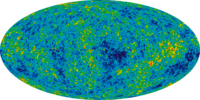
Photo from wikipedia
An important part of cosmological model fitting relies on correlating distance indicators of objects (for example type Ia supernovae) with their redshift, often illustrated on a Hubble diagram. Comparing the… Click to show full abstract
An important part of cosmological model fitting relies on correlating distance indicators of objects (for example type Ia supernovae) with their redshift, often illustrated on a Hubble diagram. Comparing the observed correlation with a homogeneous model is one of the key pieces of evidence for dark energy. The presence of cosmic structures introduces a bias and scatter, mainly due to gravitational lensing and peculiar velocities, but also due to smaller non-linear relativistic contributions which are more difficult to account for. For the first time we perform ray tracing onto halos in a relativistic N-body simulation. Our simulation is the largest that takes into account all leading-order corrections from general relativity in the evolution of structure, and we present a novel methodology for working out the non-linear projection of that structure onto the observer's past light cone. We show that the mean of the bias in the Hubble diagram is indeed as small as expected from perturbation theory. However, the distribution of sources is significantly skewed with a very long tail of highly magnified objects and we illustrate that the bias of cosmological parameters strongly depends on the function of distance which we consider.
Journal Title: Physical Review D
Year Published: 2019
Link to full text (if available)
Share on Social Media: Sign Up to like & get
recommendations!